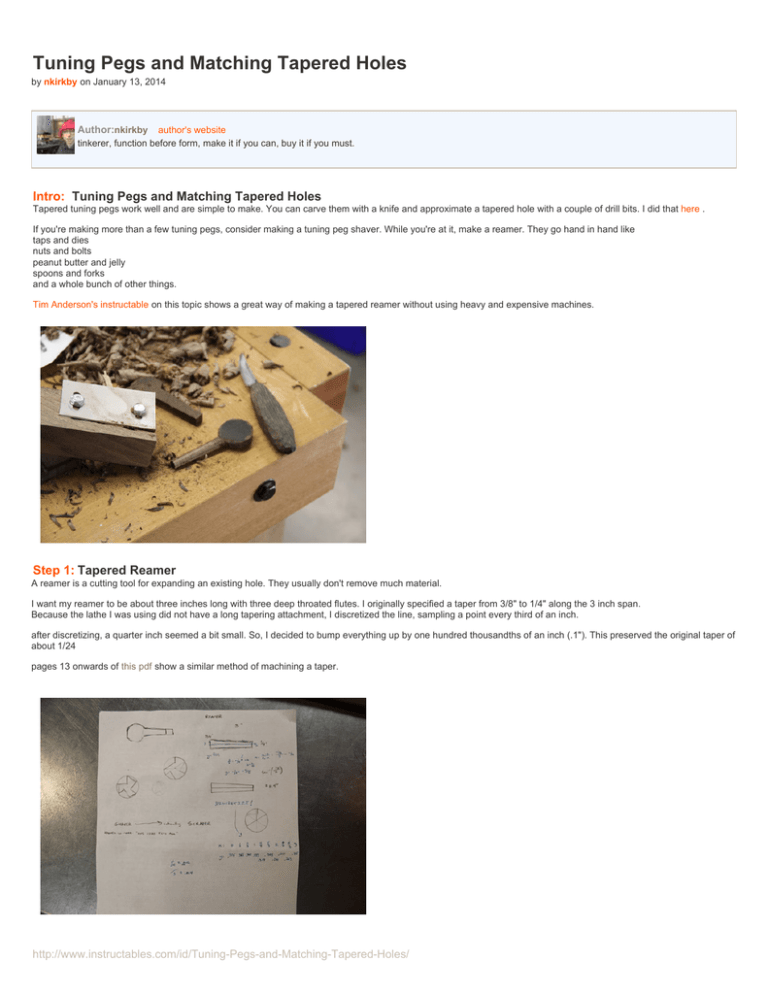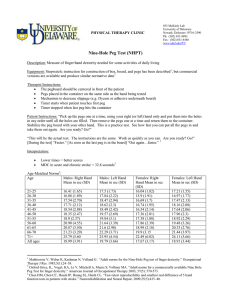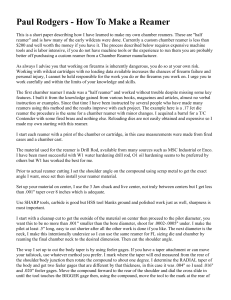Instructables.com - Tuning Pegs and Matching Tapered Holes
advertisement

Tuning Pegs and Matching Tapered Holes by nkirkby on January 13, 2014 Author:nkirkby author's website tinkerer, function before form, make it if you can, buy it if you must. Intro: Tuning Pegs and Matching Tapered Holes Tapered tuning pegs work well and are simple to make. You can carve them with a knife and approximate a tapered hole with a couple of drill bits. I did that here . If you're making more than a few tuning pegs, consider making a tuning peg shaver. While you're at it, make a reamer. They go hand in hand like taps and dies nuts and bolts peanut butter and jelly spoons and forks and a whole bunch of other things. Tim Anderson's instructable on this topic shows a great way of making a tapered reamer without using heavy and expensive machines. Step 1: Tapered Reamer A reamer is a cutting tool for expanding an existing hole. They usually don't remove much material. I want my reamer to be about three inches long with three deep throated flutes. I originally specified a taper from 3/8" to 1/4" along the 3 inch span. Because the lathe I was using did not have a long tapering attachment, I discretized the line, sampling a point every third of an inch. after discretizing, a quarter inch seemed a bit small. So, I decided to bump everything up by one hundred thousandths of an inch (.1"). This preserved the original taper of about 1/24 pages 13 onwards of this pdf show a similar method of machining a taper. http://www.instructables.com/id/Tuning-Pegs-and-Matching-Tapered-Holes/ Step 2: Reamer Turning I faced and made a divot in the end of the stock to accept a live center. Next, I roughed out the taper. The lathe I was working with had a digital readout. That made it easy to guide the cutter to each of the points. If I didn't have a digital readout, I would have scribed the ten locations along the axis of rotation, then plunged to the appropriate depth for each location. After that, I carefully filed the steps to blend them together. I stopped filing when marks from the roughing operation disappeared. Next, I used a form tool to radius the transition from the largest diameter of the reamer to the original stock diameter. This was mostly aesthetic. In legit (R) high torque applications, it's considered bad practice to have a sharp changes in diameter on a shaft because they will concentrate stresses. when you're satisfied with the taper, part it off. http://www.instructables.com/id/Tuning-Pegs-and-Matching-Tapered-Holes/ Step 3: Milling the flutes This operation is slightly squirrely because of the workpiece's ability to deflect under the milling forces. I chose to climb mill because I was worried that the relatively floppy workpiece would be pulled into the cutter by conventional milling forces. I'm not sure what the proper way of doing this is. I did it slowly, about 500 RPM on a 3/4" end mill at a very low feed rate, and nothing complained. If I had an indexing head or a six sided collet block, I would have put the workpiece in that to advance it by 120 degrees between cuts. I didn't, so I scribed some lines using the lathe chuck jaws as a reference. I eyeballed the rotation by aligning the scribed lines with a point of tangency on one of the v-blocks. After milling, file a relief on each flute. This sharpens the cutting edge, and stops the rest of the tool from rubbing on the walls of the hole. I drilled a couple of holes in the handle end of the tool to accept a piece of 1/4" square steel stock and a set screw. I rounded the corners of the square stock to make it more comfortable to hold. This isn't a particularly creative or comfortable handle. I didn't bother to heat treat the tool. I don't know what flavor of steel it is, and it shouldn't have to work too hard. http://www.instructables.com/id/Tuning-Pegs-and-Matching-Tapered-Holes/ http://www.instructables.com/id/Tuning-Pegs-and-Matching-Tapered-Holes/ Step 4: Peg Scraper Sort of like a pencil sharpener, but it scrapes instead of cutting. Scraping removes less material than cutting, leaves a smoother surface, and is less likely to tear the grain out. Back to the garbage we go! We're looking for a thin piece of hard steel. Discarded, dull blades (circular/table saw, planer, fat bandsaw) work well. Here, someone chucked a nice big strip of stainless steel. It's about a tenth of an inch thick, and it's tough stuff! I cut a short piece off and trued up the edge, using a big flat file like a plane. Next, I filed a stout bevel of 70 or 80 degrees on it. I milled a couple of slots in it for some wiggle room. Slightly oversize holes will work fine too. After that, drill a hole in a piece of hard wearing wood near the edge. Make the diameter of the hole the same as the tip diameter of your reamer, then ream the hole. I used a drill press with a fixturing jig but that's absolutely unnecessary. I'm at this workshop with fancy tools that I've never used, or considered using. Use a hand drill, or a brace and bit and sight the hole by eye. Once the hole has been reamed, use a plane, belt sander, drawknife, whatever, to remove material until you can see a sliver of the tapered hole all along its length. Then, drill some holes to bolt your scraper blade to the block of wood. Line the edge up with the middle of the tapered hole. My blade was too high at first, so I wedged http://www.instructables.com/id/Tuning-Pegs-and-Matching-Tapered-Holes/ some wood shavings under the other end to lower the edge into the slot. The blade should engage the peg along its entire tapered length. http://www.instructables.com/id/Tuning-Pegs-and-Matching-Tapered-Holes/ http://www.instructables.com/id/Tuning-Pegs-and-Matching-Tapered-Holes/ http://www.instructables.com/id/Tuning-Pegs-and-Matching-Tapered-Holes/ http://www.instructables.com/id/Tuning-Pegs-and-Matching-Tapered-Holes/ Step 5: Pegs Cut some roughly peg-shaped blanks from a piece of hard, tough wood. I used a piece black walnut found in the garbage. No good hardwood in your trash? Find a cabinet shop or an instrument maker or a hardwood supplier and ask if they've got any scraps. Your pegs will break or at least be rather unpleasant to carve if the grain is not parallel with the long axis of the peg. I cut my pieces on a band saw. I made them bit wider than the widest part of my reamer. I then used a knife to rough the shapes into something that would fit into the shaver. A belt sander would also work. Knives make less noise and dust. If your peg gets all shiny when you try to shave it, it is rubbing against the wood of the housing and not being shaved. Lower the blade by wedging bits of wood under the back of it, or by removing material from the top of the peg shaver block doodad. If the peg is very hard to turn, apply some wax or grease to the inner bore of the peg shaver. When I was in Missouri, a nomad taught me that earwax and nose grease (sweat, oil) make good lubricants for wooden things in a pinch. After the peg is shaved, I like to take in the sides of the head a bit. It makes the grip more comfortable. I do this with a useful hold down tool and a gouge . http://www.instructables.com/id/Tuning-Pegs-and-Matching-Tapered-Holes/ http://www.instructables.com/id/Tuning-Pegs-and-Matching-Tapered-Holes/ http://www.instructables.com/id/Tuning-Pegs-and-Matching-Tapered-Holes/ Step 6: Fancy Shaver Addendum In an effort to make pegs faster, I made a peg driver. It is a pocketed piece of aluminum with a shank on one end that can be chucked in an electric drill. This allows me to turn pegs very quickly with a drill. This had mixed results at first. The cutting forces were very high, and the drill was able to supply a lot of torque. I snapped a peg, and eventually cracked the wooden block also. Such a long cutting edge is suboptimal. Future-lathe-me will make a jig for turning tuning pegs. The old wooden block wasn't particularly comfortable or compact, so I made a new one from aluminum. I did some calculations on paper then tilted the 'nod' of the mill to about 1.2 degrees off square. Shamefully and in a hurry, I eyeballed it using the markings on the mill. I drilled a pilot hole, then approximated the taper with a series of six or eight drill bits to minimize the material that the reamer would have to remove. Next, I went in with the reamer. Conveniently, it was a snug fit in a 29/32" collet. I put the mill in the back gears to slow things down. with plenty of lube, and pecking to remove the chips, it worked. I was pleasantly surprised that my untreated tool didn't go dull while cutting aluminum. After that, I re-zeroed the nod, and faced the surface to expose the tapered hole. I wedged shims under the parallels until the slot was uniform enough for my tastes. I drilled some holes for the screws, countersinking the underside with a big drill bit. Lastly, I cleaned up all of the corners with a file. This shaver is much more rigid and works well. The top surface is flatter and more resilient than the previous version. This means that I can crank harder on the nuts without bending the cutter. http://www.instructables.com/id/Tuning-Pegs-and-Matching-Tapered-Holes/ http://www.instructables.com/id/Tuning-Pegs-and-Matching-Tapered-Holes/ Advertisements Comments 2 comments Add Comment Jackoffmanytrades says: Jan 19, 2014. 2:23 PM REPLY Love the idea, define tilt going to use it for my cbg. But wouldn't a desktop crank pencil sharpener work to make the taperd pegs? Then just cut it back how far you need. nkirkby says: that's an interesting idea, definitely worth a try. I've noticed that If the taper angle gets too steep, the peg will have a tough time 'sticking' without backing out. http://www.instructables.com/id/Tuning-Pegs-and-Matching-Tapered-Holes/ Jan 19, 2014. 3:13 PM REPLY



